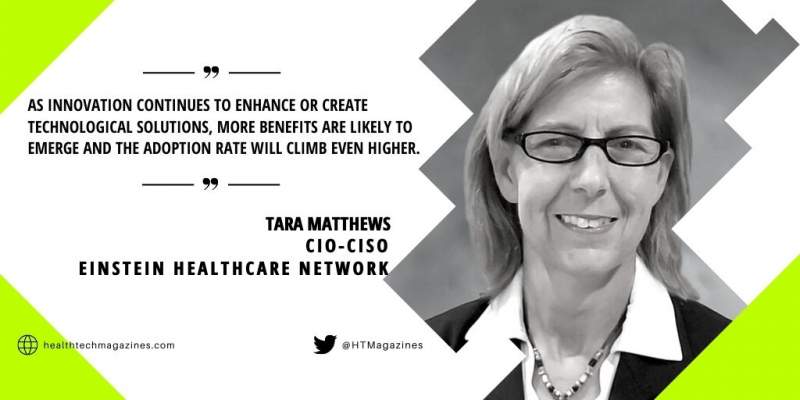Remote Patient Monitoring and Impacts with COVID-19
By Tara Matthews, CIO-CISO, Einstein Healthcare Network
Prior to COVID-19, Remote Patient Monitoring (RPM) was primarily used for the chronic care business model in a telehealth strategy. The key use cases were heart disease and chronic obstructive pulmonary disease, as well as other conditions like diabetes and hypertension. It has now spilled over to be one of the main protocols for virtual care with a usage rate increasing possibly 64.3% nationwide this year, says a new report from Frost and Sullivan. The COVID-19 pandemic placed enormous pressure on emergency departments and health systems which were already understaffed and overworked. Remote Patient Monitoring (RPM) technology can keep patents safe within the home while reducing stress on hospitals, emergency rooms, and the front-line health care workers.
Although prior to the COVID-19 pandemic, many hospitals and health systems have adopted some form of remote patient monitoring but achieving this at scale has been a challenge. The demand has provided an opening for an influx of new players to the market. Many of the larger, well-established vendors already had digital platforms for virtual care and remote patient monitoring was just another module. The challenge for healthcare delivery organizations was fast-tracking procurement and deployment. Several market newcomers offered stand-along solutions that could be deployed in days, not weeks or months, plus at a significantly lower cost. The challenge from this aspect was integration to the EHR and if not, would cause an additional burden. For example, having data return from a monitoring device in the form of a CSV or other format that would need to be re-entered into the EHR record. Some solutions have been built on FHIR standards and APIs available for building custom integrations; thereby, allowing customization and integration. However, that takes resources and time which hospital delivery organizations don’t have the luxury of having. What would be much better is the direct integration of all the data, in real-time, to the Electronic Health Record (EHR). Additionally, having the data filtered, based on set markers, to notice trends, pick up patterns, and provide meaningful alerts.
From an adoption perspective, the introduction of new billing codes starting back in 2018 from the CMS, increased some adoption success, but the COVID-19 pandemic accelerated it substantially. Fifty-nine percent of consumers say they are more likely to use telehealth services now than before COVID-19, according to a recent Black Book Market Research survey. Telehealth and remote patient monitoring services provide a continuous connection at any time. Patients love the fact it’s more convenient, time-saving, and feel more connected to their provider. They feel a sense of assurance and peace of mind on a daily, ongoing level. All this can be measured by the increase in patient satisfaction scores and patient engagement statistics. From the clinician’s point of view, the ease of access to patient data and the ability to provide higher-quality care to a larger base makes it a win-win. Finally, healthcare providers are encouraged by lower costs and higher efficiency. Additionally, they see the value of a layered approach and understand the value of the home setting. As innovation continues to enhance or create technological solutions, more benefits are likely to emerge and the adoption rate will climb even higher.
Of course, let’s not forget the risk introduced when this technology is in a patient home setting which may not have proper security controls (cyber or physical) to prevent compromise. Patients are able to forward the monitoring data to their physician at regular intervals and can possibly initiate audio and video communication with their care team providers. Physicians receive patient data through the monitoring platform with equipment that captures the patient data and allows real-time audio and video interaction with the patient. Data may be transmitted across the patient’s home network and routed across the public internet. This provides opportunities to exploit vulnerabilities which then can be used to access critical systems of the supplier or possibly the healthcare system. The increase in connectivity points remains a major challenge and developing real-time security is a key obstacle. Some individual devices, at-home patient monitors, and remote-care devices have no embedded security at all. As this technology is more widely adopted, the building blocks of cybersecurity — confidentiality, integrity, and availability – must be integral to the platforms in use now and into the future.
As the world continues its response to the COVID-19 crisis, the entire healthcare system has come together in extraordinary and innovative ways to overcome major obstacles and tackle new challenges. Remote patient monitoring is a critical piece of the virtual care platform that will continue to develop and gain traction providing access to all and delivery of critical data to make the best-informed decisions to treat patients.



